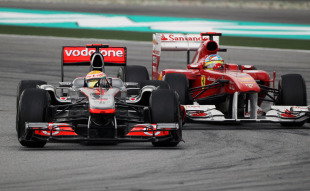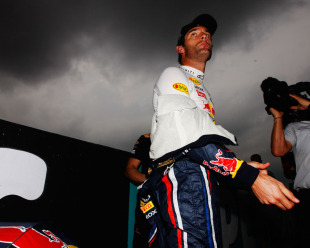
- Race:
- Malaysian Grand Prix
- Championship:
- FIA Formula One World Championship
- Drivers:
- Karun Chandhok
The Malaysian Grand Prix was the first true indicator of what we can expect this season. As I said in my last column, the circuit in Melbourne is a bit unique and isn't really representative of what we could be looking at for the rest of the season. I think the race on Sunday was a real boost for the new for 2011 rules, showing that the DRS and especially the tyres have made the racing a lot more exciting to watch for the fans.
McLaren were very impressive in qualifying and the fight for pole was an incredibly close battle with the top four drivers all being the only ones able to run two new sets of option tyres in Q3. Christian Horner and Adrian Newey have both been quoted saying that Red Bull were more focused on the race and while that definitely paid off for Seb Vettel on Sunday, the small gap would certainly have been met with some smiles from Woking after the massive 0.778 second deficit in qualifying at Albert Park.
The tyres were the main talking point, with the more abrasive surface of Sepang combined with the much higher temperatures than in Melbourne all greatly influencing tyre wear. There were a few things that really stood out - one that I predicted in my preview and one that I'll admit I was wrong about. The first is that as I expected, the tyres are having a bigger influence on the racing than the DRS or KERS with drivers on new tyres sometimes lapping two seconds faster than others on worn ones.
Jenson Button proved that by being silky smooth and looking after the tyres, you can gain massively in the race. I really didn't expect this to pay off as much as it did for him. I thought that once the tyres start to degrade and the cars are sliding around more, guys like Lewis who are more comfortable with the car moving around will benefit but that wasn't the case, in Malaysia at least. I'm sure Mclaren and Lewis' side of the garage in particular will be analysing how they can be kinder to the tyres as it clearly paid off for Jenson.
Some of Lewis' issues came from being forced to run a set of used prime tyres in the race. Let me try to explain a bit for the people at home how the tyre allocation works - basically, not counting the special development sets, each car gets 11 sets of tyres for the weekend which are six prime and five options. With the current rules drivers use one set of primes in FP1 and one set each of prime and options in FP2 and FP3. So that leaves you with three new primes and three new options going into qualifying which is where it gets tricky.

This means that for the race the guys who made Q3 would all have the three sets of used options from qualifying and one new set of primes, whereas the guys further down may have another one or two new sets of tyres for the race. In Lewis' case, I understand he flat spotted one of his option tyres in qualifying and was thus left to run a used prime set in the race for his final stint which proved to be disastrous.
While the weekend went as close to perfect as possible for Seb Vettel and Jenson had a very strong showing to get his first podium of the year, others around them were having all sorts of issues. I really feel for Mark Webber and he must be wondering what he has do to get his season going better from here on.
Everything looked good on Friday with the fastest time in both sessions but come Saturday he was outqualified by Seb and Lewis and at the start on Sunday lost out big time, in part because I understand his KERS wasn't working off the line which left him down in 10th on lap one. The team strategists and Mark's race engineer Ciarron Pilbeam must have worked overtime to switch him onto a four stopper. They had to find spaces in the traffic so he was able to use empty gaps and strong race pace on fresh rubber to work himself back into a decent position. The Aussie produced a typically gritty drive to make the best of a tough start.
Fernando and Ferrari were surprisingly far away from the pace all through Friday and Saturday, but come Sunday they had pockets of strong speed and indeed were at one stage looking good to get on the podium. The guys from Maranello will be a little relieved with the pace from the Spanish ace in the race, but I'm sure there will be plenty of analysis going on to understand more about the lack of single lap pace in qualifying. In the end, it was an unfortunate tap from Fernando's front wing on to Lewis' rear right tyre that ended his chances of a podium and left him to take sixth place instead.

For us at Team Lotus, our home race gave us our strongest result to date. For the first time in standard dry conditions, the cars were genuinely within half a second of the pre-2010 established teams, both in qualifying and in race pace which was very encouraging. Heikki's car ran reliably in one of the toughest races of the year and it was a clear indication that the team has taken a step forward from last year. It's a big uphill task in F1 for a new team to take on the establishment within 18 months and the focus now switches to the development race through the season.
Karun Chandhok gives his views exclusively to ESPNF1 at the end of every grand prix weekend

